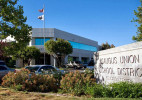WASHINGTON, DC – On Tuesday, the House Committee on Science, Space, & Technology favorably reported H.R. 5503, the National Aeronautics and Space Administration (NASA) Authorization Act of 2018 by a vote of 26 to 7.
Rep. Steve Knight (R-CA), a member of the Committee, voted in support of the bill that authorizes approximately $21 billion for various science, research, and technology programs.
The final version of the bill includes several key provisions from Rep. Knight’s Aeronautics Innovation Act (H.R. 3033). First, the bill codifies NASA’s civil experimental “X”-Plane program to evaluate and prove technology concepts that can be applied to civilian air travel. This program encompasses the Low Boom Flight Demonstrator (LBFD) program, ultra-efficient subsonic aircraft, the fully electric X-57, and other projects that are critical to developing the technology that will secure American aviation’s technological advantage for the next generation. Another included provision from H.R. 3033 prioritizes the Aeronautics Research Mission Directorate’s (ARMD) hypersonic technology research, which will strengthen its role in supporting the Department of Defense’s pursuit of these technologies. Lastly, a new sub-account under the Construction of Facilities account is established to be dedicated to Aeronautics research centers to ensure these sites have the resources they need to achieve their research and testing objectives.
“Aeronautics is the first “A” of NASA and is my first priority on the Science Committee,” said Rep. Knight “The programs supported by this bill each represent the potential for generational leaps in aerospace and flight technology. Historically, American leadership in these fields has improved the lives of people in every part of the world. I’m very happy we were able to include important elements of the Aeronautics Innovation Act into this Authorization bill.”
H.R. 5503 also supports consistent funding for multiple programs with heavy production and development assets in Southern California. These include, but are not limited to supersonic flight research, the Space Launch System, Orion rocket, and the James Webb Space Telescope. Additionally, a bipartisan majority of the Committee approved a final Amendment by Rep. Knight that provides additional support to the LBFD program.
“Chuck Yeager broke the sound barrier over 70 years ago,” said Rep. Knight “Yet for whatever reason, this hasn’t translated to widespread commercial and civilian applications. If we can find a way to dampen the sonic boom of commercial aircraft, it could spark a revolution in commercial air travel and allow us to accomplish speeds and convenience never seen before. My amendment advances this goal by supporting the Low Boom program and assessing what resources and infrastructure are needed to get it off the ground.”
“My family, and our community here in the Antelope Valley, have a proud legacy of leadership and innovation in the aerospace sector. I am proud to have played a role in forming this legislation and setting the groundwork for future generations of American aviators, designers, and manufacturers,” said Rep. Knight “We will ensure the future of flight is American.”
Like this:
Like Loading...
Related





 Tweet This
Tweet This Facebook
Facebook Digg This
Digg This Bookmark
Bookmark Stumble
Stumble RSS
RSS


























REAL NAMES ONLY: All posters must use their real individual or business name. This applies equally to Twitter account holders who use a nickname.
No Comments